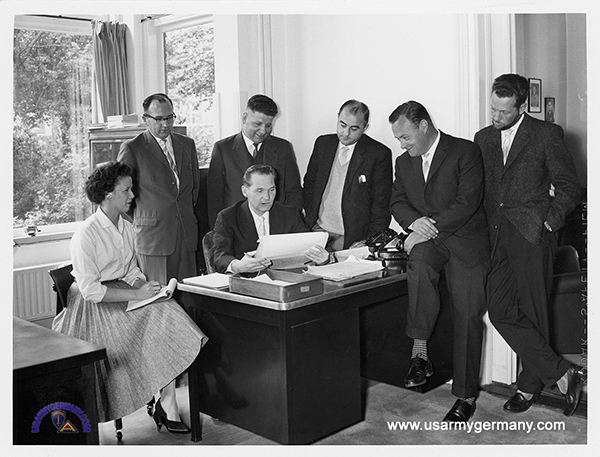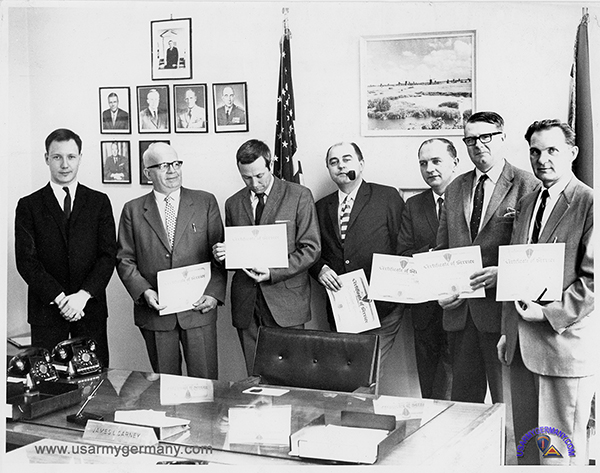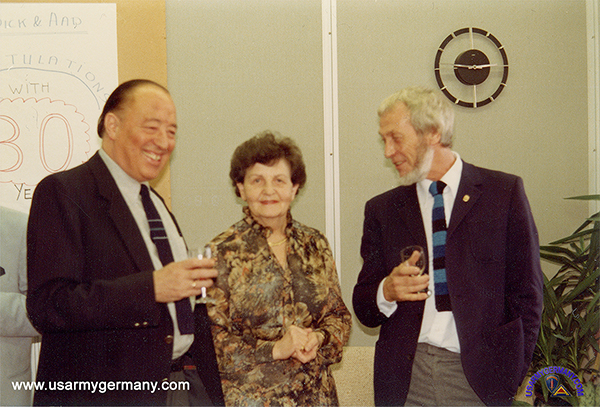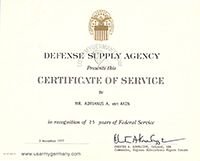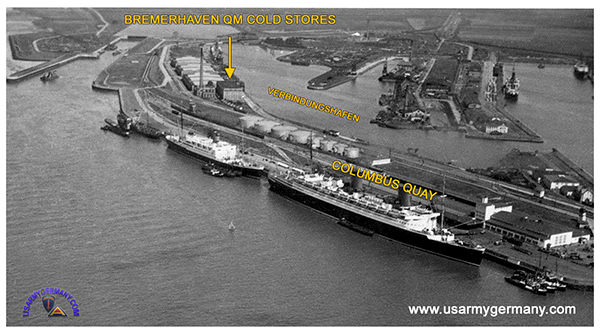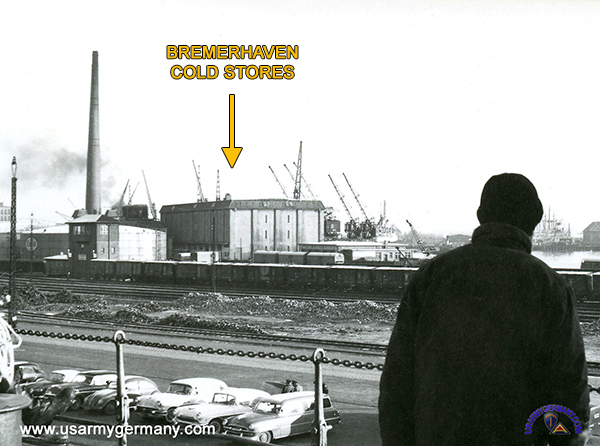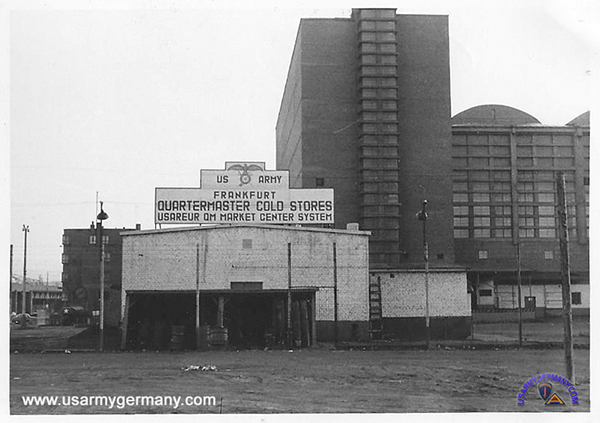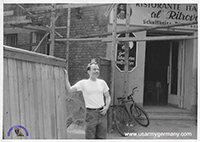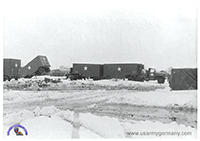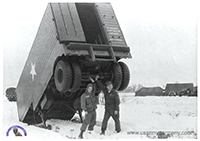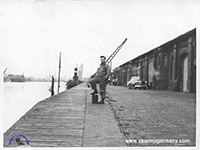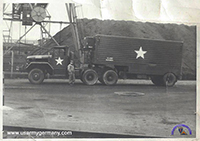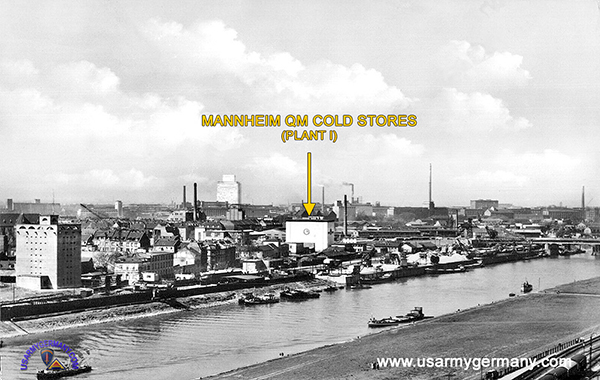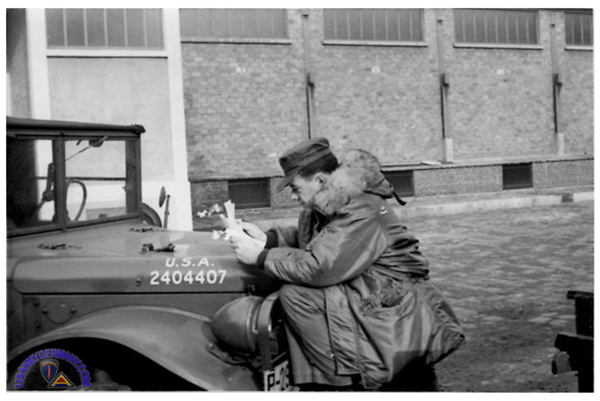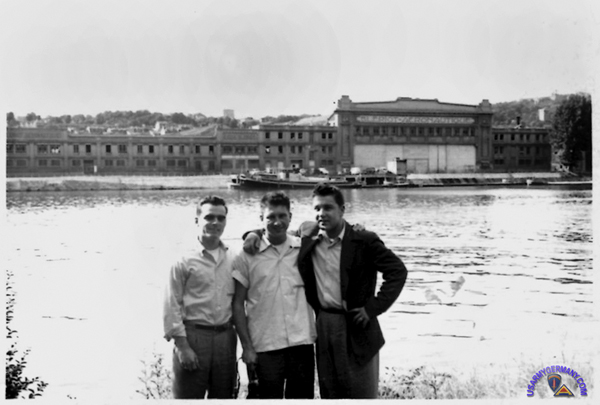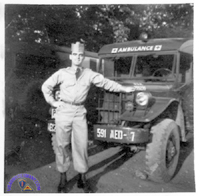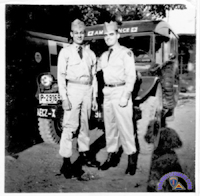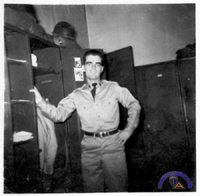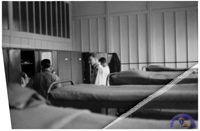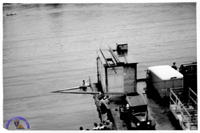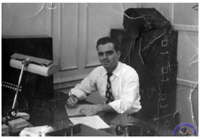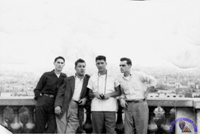| If you do NOT see the Table of Contents frame to the left of this page, then Click here to open 'USArmyGermany' frameset |
|||||||||||||||||
Quartermaster Market Center |
|||||||||||||||||
|
|||||||||||||||||
| USAREUR Quartermaster Market Center | |||||||||||||||||
 |
|||||||||||||||||
| 1955 | |||||||||||||||||
| (Source: STARS & STRIPES, Nov 21, 1955) | |||||||||||||||||
| The huge cold stores installation at Bremerhaven will soon be placed under the control of the USAREUR Quartermaster Market Center in Frankfurt. The transfer will be the final move in a program designed to consolidate responsibility for perishable food storage and distribution in USAREUR, Col W. W. Vaughn, Market Center CO, said. Cold storage plants in quartermaster depots throughout USAREUR gradually have been absorbed by the market center during the past five months. |
|||||||||||||||||
| 1956 | |||||||||||||||||
| (Source: STARS & STRIPES, Feb 20 1958 and Northern Area Command Telephone Directory, 15 February 1956) | |||||||||||||||||
|
|||||||||||||||||
| 1958 | |||||||||||||||||
| (Source: STARS & STRIPES, June 20, 1958) | |||||||||||||||||
| The Quartermaster Market Center in Frankfurt is scheduled to merge with the Giessen QM Depot later this year (by Sept 1). (The Army QM Supply and Accounting Center in Giessen will be merged with the Giessen Depot on July 2.) These actions will bring QM procurement, supply control and depot operations under one roof and result in economies in overall manpower and requipment requirements as well as increased efficiencies and service levels. The new organization will be called the Giessen Army QM Supply Center. |
|||||||||||||||||
| |
|||||||||||||||||
| 7853rd Army Unit, Quartermaster Market Center (a.k.a. USAREUR Procurement Center) | |||||||||||||||||
| The Hague Field Office | |||||||||||||||||
| (Source: Email from Daniel van Aken) | |||||||||||||||||
| My father, Adrianus Alidus (Aad) van Aken, worked as a Dutch civilian inspector for The Hague Field Office for more than 30 years, starting in 1952. The Hague Field Office (also known as 'The Hague Purchasing Office') was located at Jan van Nassaustraat 125 in The Hague. which again fell – probably- under the US Army Quartermaster Supply Center Giessen (Germany) until about the mid-1960s. Later their office moved to the US Embassy in The Hague. In the 1950s and 1960s, my father took care of the purchase and inspection of potatoes, vegetables and fruit according to the strict specifications of the American Army for the U.S. military personnel and dependents stationed in Western Europe. The fruit and vegetables were mainly intended for the 'commissary' at the US military bases in West Germany. He traveled a lot in Holland, Belgium and Germany to get all the required products. From the '70s on he mainly worked at the wholesale market for fruit and vegetables in The Hague, Holland. Initially, mainly American servicemen (5 to 6) worked at the office, who stayed here for years. Sometimes a Dutch colleague, Mr. Bookelman. One of his bosses was W.X. Kealey. Other colleagues: Maxwell B. Fogarty (Col. QMC); Captain James, L. Carney; Mr. Bittner; Mr. Forman; Mr. Thoen; Mr. Prevost. In his last year he had a woman as his superior (name unknown, see picture). |
|||||||||||||||||
|
|||||||||||||||||
| |
|||||||||||||||||
| Cold Stores | |||||||||||||||||
| Bremerhaven Quartermaster Cold Stores | |||||||||||||||||
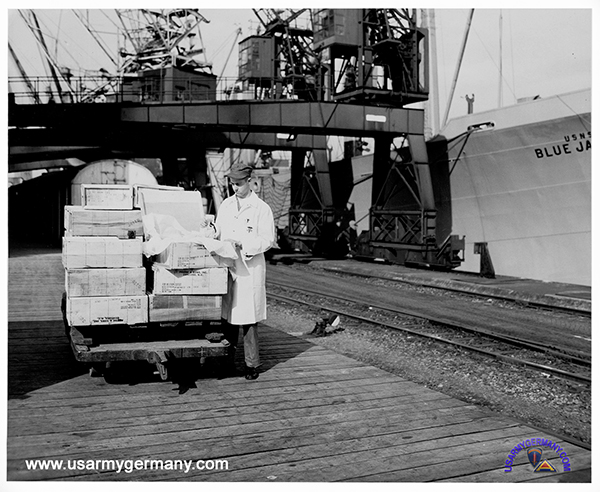 USNS BLUE JACKET, US Navy refrigerator ship moored alongside the Bremerhaven Cold Stores |
|||||||||||||||||
| 1958 | |||||||||||||||||
| (Source: STARS & STRIPES, April 20, 1960) | |||||||||||||||||
| Bremerhaven Quartermaster Cold Stores The Bremerhaven Cold Stores plant is a large warehouse where perishable foodstuffs coming from the U.S. by ship are held in storage for US Forces in Europe. The temperatures held in the cold storage facility range down to zero degrees Fahrenheit. In the past 12 months, 72 vessels carrying perishable subsistence destined to US forces have been off-loaded at Bremerhaven. Lt Col Harrison Francis is the current commanding officer of the Cold Stores installalion. The Bremerhaven Cold Stores were originally requisitioned by the US Army's Port of Embarkation in 1945. Today the installation operates under the control of the Quartermaster Supply Center, Giessen. The facility is located on the waterfront in the Verbindungshafen area of the Port of Bremerhaven and is readily accessible to ships arriving from Stateside. A railway siding runs along the length of the building on one side and, on the other side, there is loading platform for long-haul refrigerated (REEFER) trucks. Frozen foods are shipped by train to other US Army cold storage facilities in Paris, Munich, Leghorn (Italy) and Kaiserslautern 1) or by truck to 28 locations that can be conveniently reached by refrigerated (REEFER) trucks. The cold storage plant employs a permanent work force of 75 US and local national employees, in addition to 4 US military personnel (including Lt Col Francis). In a rush, the facility can draw on an additional 30 men from the local stevedore pool to help in unloading ships. 1) Webmaster note: At the time of this article, the Kaiserslautern Cold Stores had become operational and the former Munich, Mannheim and Frankfurt Cold Stores facilities had been closed. |
|||||||||||||||||
| Frankfurt Quartermaster Cold Stores | |||||||||||||||||
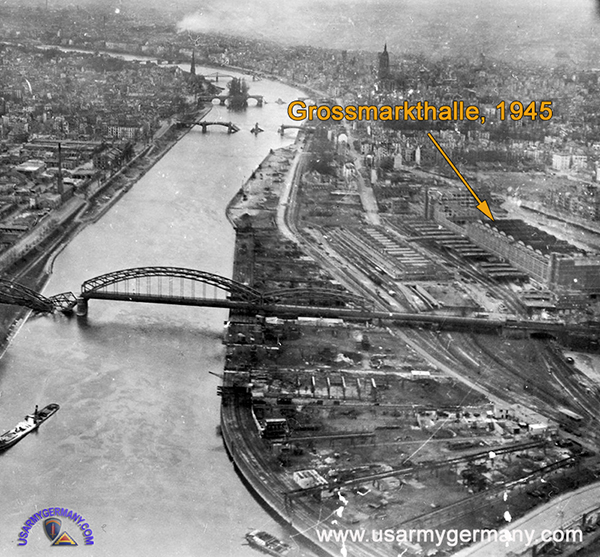 Grossmarkthalle and Main River, aerial reconnaissance photo, Army Air Corps, 1945 |
|||||||||||||||||
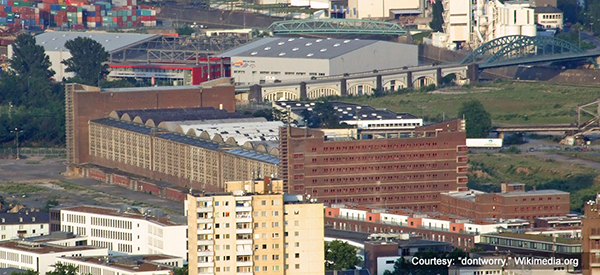 The Grossmarkthalle in 2007 - the structure has been torn down recently (Dontworry) |
|||||||||||||||||
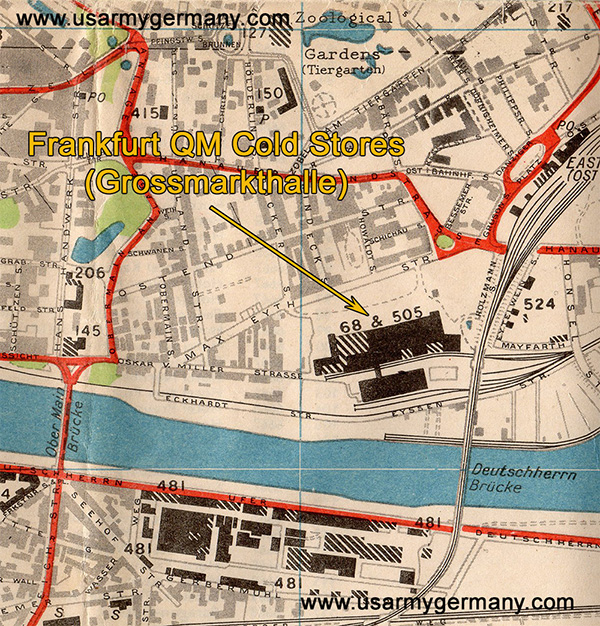 Frankfurt QM Cold Stores, Frankfurt, 1945 (Webmaster's collection) (Section of a Town Plan for Frankfurt a.M from 1945; |
|||||||||||||||||
| 1945 | |||||||||||||||||
| (Source: Email from Philip Sarver) | |||||||||||||||||
| My name is Philip W Sarver, MSgt, USAF (Ret). I am researching my father's military history and have been trying to locate unit history for his unit in Germany. He was in the US Army 1945-46 with an MOS of 345 Truck Driver Light. His WD AGO Form 53-55 states that his organization was Det A 284th QM Refrigeration Co. I have reason to believe that this was a “fixed” unit located in Frankfurt Germany in what he called (on the back of some of his pictures) The Plant. I believe that this facility was the “old large market” building located on the north side of the river east of the Eiserner Steg (The Iron Bridge), and I think it is now in current day the European Bank. He also has a couple of pictures showing a sign on a building that reads “56th QM Base Depot Guard Quarters”. I am not sure if his company was part of 56th QM or not. I do see in your list of companies that the 284th QM Co is listed but there is no further information. I am trying to find out the organizational lineage of his unit. Any and all information is greatly appreciated. ADDITIONAL INFORMATION My father was Harold Lowell Sarver of Covington Ohio who enlisted or was drafted into the Army at Fort Hayes, Columbus, Ohio 13 Jun 1945 (abstracts from Fold3 and Ancestry). He then went to Ft McClellan, Alabama for Basic Training/Boot Camp (newspaper clipping dated 31 Oct, 1945). Following Basic he had a 10-day furlough during which he got engaged and then was to report to Camp Pickett, Virginia, on 8 Nov 1945 (same newspaper clipping dated 31 Oct, 1945). What he did at Camp (later Fort) Pickett is unknown at this time but I would assume either training as a Truck Driver Light 345 (WD AGO Form 53-55, block 30) or preparations for shipping over to Europe as his WD AGO shows he at least received a Typhoid shot in Nov 45. His WD AGO Form shows a date of departure of 17 Nov 45 with destination France arriving 24 Nov 45. It also shows a departure of 11 Sep 1946 with destination United States arriving 21 Sep 1946 with a Date of Seperation of 22 Nov 1946 from Fort George G Meade MD as a Private First Class date of rank 10 May 1946. His WD AGO Form 53-55 shows his organization as DET A 284TH QM Refrigeration Co; Arm or Service as QMC and Component as AUS. Attached are several photos taken in Germany. Most are of "The Plant" as he called it or the Cool House which you said were called Cold Stores located in the Grossmarkthalle on the Main River just east of the Eiserner Steg or Iron Bridge. There are also some of the Hotel that they were bunked at which was across the street/lot from the Plant. The first floor of the Hotel had a Mess Hall in it as well. There are some pics of trucks only to show that the front bumper was painted with unit identifications, one showing a sign for the unit, and three showing a steeple (the Kaiserdom St. Bartholomaus) in the background that shows location as well. I hope they are helpful to you and useful for display on your website. |
|||||||||||||||||
|
|||||||||||||||||
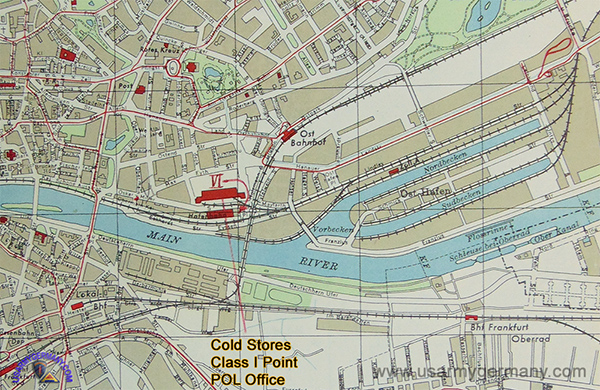 Location of Frankfurt Cold Stores & Class I Point (Northern Area Command History, 1952) |
|||||||||||||||||
| 1956 | |||||||||||||||||
| (Source: Email from Charles "Jim" Rose) | |||||||||||||||||
| I served with the 552nd QM Refrigeration Company in Frankfurt, Germany, 1956-1958. We were billeted at the Gutleut Kaserne on Gutleutstrasse. We traveled most of northern Germany and to Verdun, Nancy and Metz, France. I'm not sure of the address of the Frankfurt cold stores. It was in the city on the way to Hanau, next to the Class One Point. When I left in September of 1958, we were still hauling produce to Rhine Main airfield for the uprising in Lebanon. I am inlcuding pictures from when I was there and would like to hear from anyone who was there at about that same time. Webmaster's note: The Cold Stores at Frankfurt were located in the city's Wholesale Market Hall (Grossmarkthalle) on Oskar-von-Miller Strasse in the Ostend of Frankfurt. The massive structure on the right bank of the Main River was constructed in 1928. For some more recent photos and information on the old Frankfurt Grossmarkthalle, see the relevant Wikipedia Page. |
|||||||||||||||||
|
|||||||||||||||||
| Kaiserslautern Quartermaster Cold Stores | |||||||||||||||||
| Click here to see the Kaiserslautern Cold Store section on the Defense Logistics Agency Page. | |||||||||||||||||
| Mannheim Quartermaster Cold Stores | |||||||||||||||||
| 1958 | |||||||||||||||||
| (Source: STARS & STRIPES, May 22, 1958) | |||||||||||||||||
| Mannheim Cold Stores Cold stores in Mannheim, Munich, Paris and Bremerhaven, handle all of the troop issue and commissary resale stocks in frozen foods for the entire USAREUR area. Additional stores in Frankfurt and Berlin store and issue perishables, but do not have facilities for long-range storage of frozen subsistence. The QM Market Center in Frankfurt has operational control of the cold stores. The Mannheim Cold Stores are comprised of two six-story buildings about a mile apart. One officer, 7 enlisted men and 59 German nationals are employed at the Mannheim plant. The Mannheim stores ship Army subsistence to approx. 60 installations, including to points as distant as Italy and Egypt. Foods arrive from two sources - the US and Europe. Stateside products arrive twice a month on two special cargo ships and dock at Bremerhaven. From the port the cargo travels by rail or truck trailer to Mannheim or one of the other stores where it is then stored for issue. Once the cargo has arrived at the Mannheim rail yards, the refrigerated cars are sided near the cold stores where a converted Army truck (a "six-by") is used to pull the cars along the spur track to the unloading ramp. One unique aspect of the Mannheim Cold Stores is that it stores and issues all of the ice cream provided to American forces and their dependents in Europe. They handle about 104,000 gallons a month. This consists of three standard flavors (vanilla, chocolate and strawberry) and the special "flavor of the month," such as butter pecan, black raspberry or other flavors. |
|||||||||||||||||
| Metz Quartermaster Cold Stores | |||||||||||||||||
| 1952 | |||||||||||||||||
| (Source: Email from George McKeon) | |||||||||||||||||
| After Basic Training at Camp Breckinridge in the Winter of October to February 1952-1953 I arrived at the Schweibrucken Replacement Depot in Germany in March 1953 and was assigned to the 574th QM Service Company in Metz, France, at Colin Caserne. Although I had an Infantry MOS, I also could type. Therefore I was sent to Metz, France and assigned as a Company Clerk. | |||||||||||||||||
| METZ COLD STORES My recollection of the recently (1951) taken over Colin Caserne on Rue General Franiatte in Metz, France, by the US Army, which developed the Metz QM Depot, was of 574th QM Service Company, the 514th QM Subsistence Company, a Petroleum outfit, the 591st Medical Detachment, a Polish Labor Service Company, composed of ex-Polish Army personnel, and some Polish Displaced Persons. They performed labor duties and fundamental security duties. All these personnel were barracked in the Main Building with other Companies. As I recall, there were also some Canadian Air Force personnel on the base. The 574th was essentially an all Black outfit at the time, as Army Desegregation ordered in 1948 had not fully been implemented by 1953. Its CO was Captain Thysel,l a white officer. I got along well with all the guys in the outfit although I was the only white guy there. In fact, there some who had trouble reading and writing. I volunteered in my capacity as Company Clerk to write/type letters for some who had such difficulty in reading and writing. My effort was appreciated. There was a Cold Storage Plant down by the main railroad marshalling yards which were operated by the 514th QM Subsistence Company. The 514th received, stored and distributed frozen and chilled meats, fresh eggs, vegetables and other items for Mess Halls in Eastern France. The Cold Storage Plant was right next to the Marshaling Yards near Rue de Castenau. The Cold Stores were always near the train yards, not the stations themselves. As I recall, the plant was in a commercial area across from the tracks, no siding was brought into the location. It was about 4 stories high. The admin office were on the property and composed of several one story buildings, shacks if you will. Essentially, the same configuration as the Paris Cold Stores plant but on a smaller scale. While I was in Metz, there was an IG Inspection of the nearby Woippy QM Supply Depot which was located near Metz. A myriad of problems were uncovered that were the result of the hasty construction and poor methods of storage when the depot was first occupied. Problems of poor management and faulty operations were highlighted in the IG report. One result was an order from up top to get the place cleaned up and straightened out within the month or heads would roll. All personnel of the 574th, the 514th and all clerks were to go to Woippy to work with the Woippy personnel to get things in order. It was a mess. I had the job along with others of tearing down stacks of squad tents about 18 feet high which had sunk into the ground covering 3 layers of tents. No pallets had been used when they had been stacked there some years before. After taking down the stacks and digging out the sunken tents, the huge holes had to be filled in so that the tents could be restacked. However, before the stacking could be done we had to find and repair discarded pallets for use in the restacking operations. There was considerable loss of all sorts of equipment due neglect, weather and theft. The place was a mess. I was there for a week doing my Morning Reports at night back at the Orderly Room along with other necessary Administrative Work. |
|||||||||||||||||
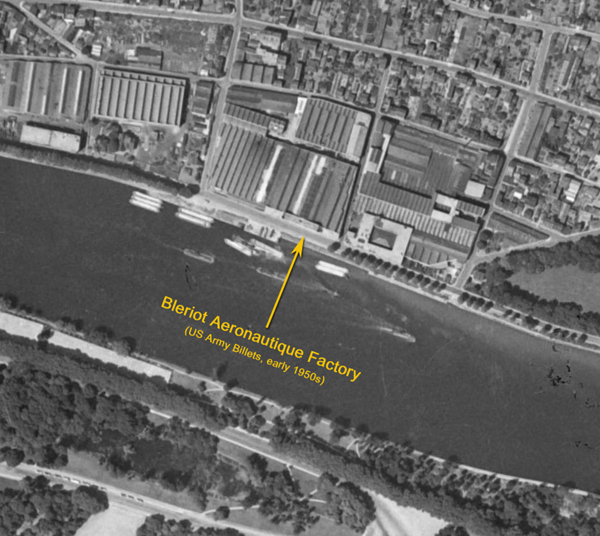 Former Bleriot Aeronautique factory in Suresnes (Paris) served as Army billets in the early years of COMZ (IGN website) |
|||||||||||||||||
| PARIS COLD STORES When I went to Paris I was billeted in the old Louis Bleriot Aircraft Factory on the River Seine at Quai Leon Blum in Sursenes a suburb of Paris right near an American military Cemetery. I was attached for rations and quarters with the 7867th QM Depot Composite Group, but with the 552nd QM Refrigeration Company for administration and pay. The 7867 ran an outfit with a PX, a Commissary, a CID, an Ordnance Facility and housing for Enlisted Personnel in the Paris Area. I commuted from there to the center of Paris to an office on the corner of Rue Clement Marot and Rue de la Tremoile which headquartered the Paris QM Cold Stores commanded by Major Merrill D. Waters. The 552nd was part of the Paris QM Cold Stores. Within the same building was Paris QM Purchasing the outfit that contracted for US Army food purchases on the European Continent. Mostly vegetables, some beef from the Netherlands and all milk, eggs and cheeses and any special order items. It served SHAPE as well as USAREUR in France. My main job was as a Receiving Reports clerk. I received the paperwork/bills of lading of goods arriving by rail and/or truck from our supplier at our Cold Stores Plant next to the Gare de la Est rail yards in Paris. I checked for correctness with the counts from our Army personnel at the platforms against the Bills of Lading and if correct I prepared the Receiving Reports. It had to be signed by my Lieutenant and mailed to our finance people in Germany via French Mail rather than Army mail. The French Mail being more reliable and faster at that time. I also operated the Teletype (TTY) machine which kept me informed of rail and truck shipments coming to Paris. I received information of the shipments, progress points such as country border crossings ETAs at our Cold Store Plant. I had to chart this information on Contract Performance Wall Charts in order that Major Waters could keep track of shipments and any problems effecting delivery. One thing of mention was the Railroad Strike which occurred in 1954. With no trains the Army had to find another means of disbursing the food we had in the Cold Stores Plant. To the amazement of the strikers, US Army trucks arrived from all over France to move the food stuffs stored in the Cold Stores plants to their destination. Typically we had about 3 months supply in the plant which tided us over until the 2 week strike was over. I liked my 2 years in the Army. I was discharged as an E-4. |
|||||||||||||||||
|
|||||||||||||||||
| Paris Quartermaster Cold Stores | |||||||||||||||||
| 1955 | |||||||||||||||||
| (Source: STARS & STRIPES, Dec 28, 1955) | |||||||||||||||||
| Fresh and frozen perishable foods of the Paris Cold Stores are located in cold storage warehouses leased from Entrepots Frigorifiques de l'Union. The perishable foods stored there include butter, milk, meats, ice cream, fresh fruits and vegetables. Short hauls of the cold foods to Army and Air Force installations in and around Paris are mostly handled by the 17 refrigerator vans maintained by the Paris QM Cold Stores. Long hauls to US installations in the rest of France are handled by the 1st Transportation Company, the only TC refrigeration company in Europe. The 1st Trans Co is located at Saran (near Orleans) and has 60 REEFER vans assigned to it. About 35 of those are on the road every week. The unit's longest haul is to Bordeaux, over 400 miles from Paris. On a typical day about 12 vans leave Orleans at 6 AM and head for the Paris Cold Stores warehouse. Workers there load the refrigerator vans with the day's cargo of frozen and fresh foods. A van can carry up to 71/2 tons of food. (The drivers set the temperature in the van - 0 degrees Fahrenheit for frozen, 32 degrees for fresh foods - at the beginning of the trip.) Then the truckers drive back to Orleans, where they rest for the night. At 6 the next morning they fan out across France. Maintenance for the REEFER vans is performed by the company mechanics at Saran. They check the refrigerator vans every night and before a van sets off on a run. |
|||||||||||||||||
| |
|||||||||||||||||
| Related Links: |
|||||||||||||||||


